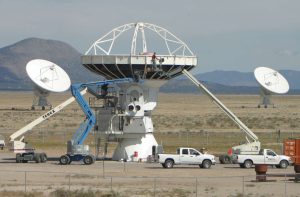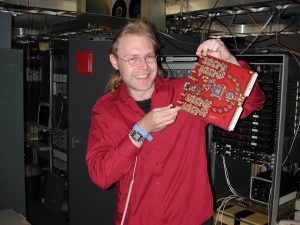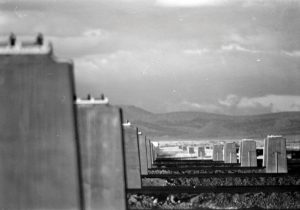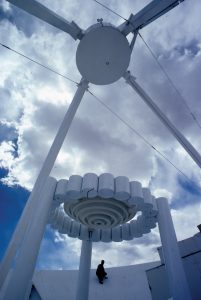In 2012, the North American prototype ALMA antenna was dismantled at the Very Large Array testing site. It was packaged and shipped to Greenland where it will be renamed the Greenland Telescope. This antenna will be part of a very long baseline interferometry project run by the United States and Taiwan.


VLA Antenna Dwarfs ALMA Antennas
Each antenna of the Very Large Array is 25 meters across. The prototype 12-meter antennas of the Atacama Large Millimeter/submillimeter Array lived at the VLA for testing, giving this rare side-by-side look at their difference in size.

Prototype North American ALMA Antenna
The North American ALMA prototype antenna was successfully tested at the Very Large Array (VLA) site in New Mexico. It was declared a success, and Vertex RSI under General Dynamics used it as a model for all North American ALMA 12-meter telescopes. This prototype was put up for adoption, and the proud new owners are the Harvard-Smithsonian Center for Astrophysics in partnership with Academia Sinica in Taiwan. They have installed it in Greenland, and its new name is the Greenland Telescope.

Electronics Innovations
Aidan Hotan, a radio astronomer visiting Green Bank from Australia, shows off a complex circuit board he designed.

Before There Were Antennas
In this artistic shot taken in the 1970s, the piers of the Very Large Array stand empty. That is because there were not yet any antennas to place on them! The VLA has 72 pads for 27 antennas, and those pads are used when the antennas are moved farther and farther apart throughout the year.

VLA’s Original Hybrid Lens
The original design of the Very Large Array antennas used a hybrid lens between the subreflector (bowl at top) and the receivers (off camera below).
This strange-looking contraption gathered radio waves coming off the subflector into tighter formation before they entered the narrow funnels (feed horns) on the receivers. The nested rings in the center of this structure act like a Fresnel lens to bend inward radio waves that are farthest apart and slow down radio waves in the very middle to keep in formation. The ring of cylinders act like wave guides for the important 21-cm waves that come from neutral hydrogen.





